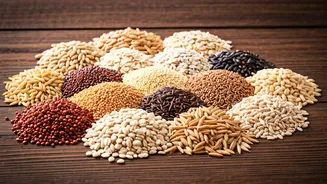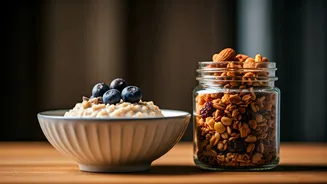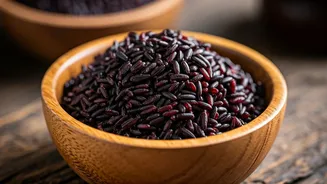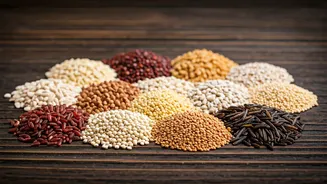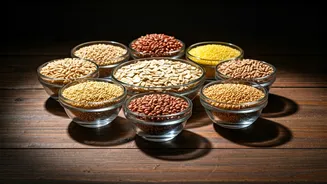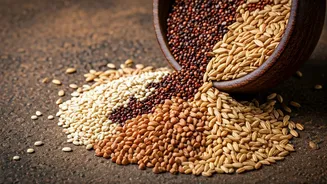Grains and Diabetes
Managing diabetes involves careful attention to what you eat. Choosing the correct grains can make a big difference in controlling blood sugar and fostering
overall health. Certain grains have lower glycemic indexes, which means they cause a slower rise in blood sugar levels. Incorporating these grains into your daily diet is a vital step toward better diabetes management. The right choice can also improve weight control, which is essential for managing diabetes. This article offers an exploration of 10 grains, detailing how they can be used to improve one's diet.
Oats: Heart-Healthy Choice
Oats are a cornerstone of a diabetes-friendly diet. Rich in soluble fiber, they slow down glucose absorption, preventing drastic blood sugar increases. Studies have highlighted their role in enhancing insulin sensitivity and reducing cholesterol levels. Oats are easily integrated into meals, from simple porridge to incorporating them in baking. Including oats in the daily diet contributes to overall cardiovascular well-being, which is especially important for those with diabetes.
Barley: Versatile Grain
Barley is another grain that offers significant benefits for people with diabetes. Barley has a glycemic index that promotes sustained energy levels. The beta-glucan fiber in barley aids in glucose control. Furthermore, barley can lower cholesterol, adding to its heart-protective properties. It is a grain that can easily be added to soups, salads, or used as a substitute for rice, making it a versatile addition to any diet.
Quinoa: Complete Protein
Quinoa is a gluten-free grain, considered a complete protein source, which is advantageous for those with diabetes. It boasts a low glycemic index, reducing the chances of blood sugar spikes. Quinoa is rich in fiber and essential nutrients, which promote satiety and aid in weight management. It's a quick and easy option that can be prepared in various forms. This grain presents a beneficial choice for those trying to maintain balanced blood sugar and a healthy weight.
Brown Rice: Nutritious Staple
Brown rice is a popular choice for its fiber content, which contributes to its low glycemic index. Unlike white rice, brown rice retains its bran layer, providing essential nutrients and fiber that slow down glucose release. This helps in maintaining stable blood sugar levels. Brown rice is an excellent staple that is easy to incorporate into daily meals. Its benefits extend beyond blood sugar control to enhance overall health, offering sustained energy levels.
Whole Wheat: Fiber Powerhouse
Whole wheat is a powerful source of fiber and can be a fantastic grain to include in a diabetic diet. It has a lower glycemic index compared to refined wheat products, preventing rapid blood sugar increases. Whole wheat offers sustained energy, keeps you feeling fuller for longer, and aids in digestion. Choosing whole-wheat bread, pasta, and other products is a simple step towards better diabetes management, contributing to both health and well-being.
Buckwheat: Unique Benefits
Buckwheat, despite its name, is not related to wheat, making it suitable for those with gluten sensitivities. Buckwheat is low in the glycemic index and contributes to controlled blood sugar levels. It's also rich in fiber, and antioxidants. It promotes cardiovascular health. Buckwheat can be eaten as groats, used in noodles, or added to other dishes. It's a nutritious option that offers benefits for diabetes management.
Amaranth: Ancient Grain
Amaranth, an ancient grain, stands out for its impressive nutritional profile. It's rich in fiber, protein, and various minerals. Amaranth has a low glycemic index, which prevents any sudden blood sugar increases. It can be used in numerous ways, such as porridges, side dishes, or even added to baked goods. Integrating amaranth into your diet provides a diverse range of nutrients and offers a viable strategy for managing diabetes and overall health.
Millet: Traditional Choice
Millet, a staple in several cultures, is becoming popular due to its health benefits. It is a gluten-free grain with a low glycemic index. Millet helps stabilize blood sugar. It's packed with fiber, promoting digestion and satiety. Millet can be cooked similarly to rice and can be added in various meals. It helps promote health. Adding millet to a diabetic diet provides diverse nutrition, aiding in the balance of blood sugar.
Spelt: Ancient Alternative
Spelt is a type of wheat that is gaining popularity because of its high nutritional content. It is a good source of fiber and protein. Spelt also has a relatively low glycemic index, allowing it to have a mild impact on blood sugar levels. Those who have diabetes can benefit from spelt by choosing products such as bread and pasta, as this can easily be incorporated into the diet. Spelt is an alternative that can lead to both better health and improved diabetes control.
